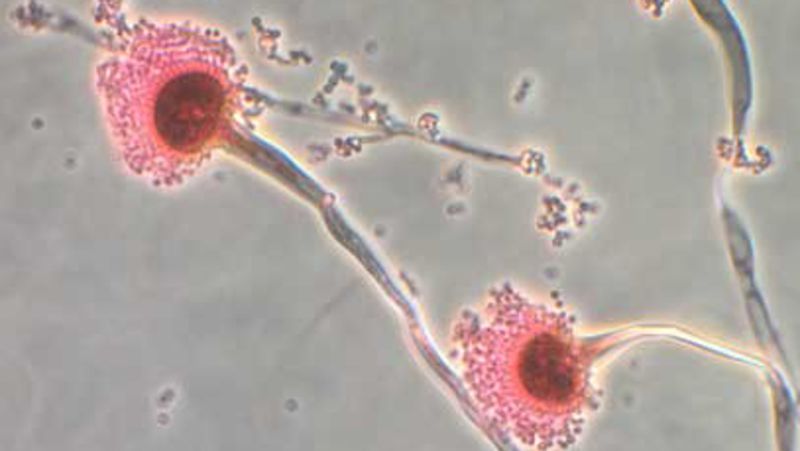World's Warming Climate: Breeding Ground For Dangerous Fungi

Welcome to your ultimate source for breaking news, trending updates, and in-depth stories from around the world. Whether it's politics, technology, entertainment, sports, or lifestyle, we bring you real-time updates that keep you informed and ahead of the curve.
Our team works tirelessly to ensure you never miss a moment. From the latest developments in global events to the most talked-about topics on social media, our news platform is designed to deliver accurate and timely information, all in one place.
Stay in the know and join thousands of readers who trust us for reliable, up-to-date content. Explore our expertly curated articles and dive deeper into the stories that matter to you. Visit Best Website now and be part of the conversation. Don't miss out on the headlines that shape our world!
Table of Contents
World's Warming Climate: A Breeding Ground for Dangerous Fungi
The world is getting warmer, and with rising temperatures comes a concerning rise in something else: dangerous fungi. Climate change is creating a perfect storm for the proliferation of fungal pathogens, posing significant threats to human health, agriculture, and ecosystems worldwide. This isn't just a future concern; it's a problem unfolding now.
Rising Temperatures and Fungal Growth:
Fungi thrive in warmer, more humid conditions. As global temperatures increase and weather patterns become more erratic, many fungal species are expanding their geographic ranges and growing seasons. This means increased exposure for humans and animals to potentially harmful spores, leading to a greater risk of fungal infections. The impact isn't limited to human health; agriculture is also significantly threatened.
Impact on Human Health:
Several fungal diseases are already on the rise, and climate change is exacerbating the issue. For example, Coccidioides, a fungus responsible for valley fever, is spreading into new areas due to warmer, drier conditions. Similarly, Histoplasma capsulatum, which causes histoplasmosis, is becoming more prevalent in regions experiencing increased humidity. These infections can range from mild to life-threatening, particularly for individuals with compromised immune systems. The increased incidence of these fungal infections is placing a strain on healthcare systems and resources globally.
Threats to Agriculture and Ecosystems:
The agricultural sector is also facing significant challenges. Fungal plant diseases, such as wheat rust and soybean rust, are becoming more aggressive and widespread, leading to reduced crop yields and food insecurity. These diseases can devastate entire harvests, contributing to economic losses and food shortages, especially in vulnerable regions. Beyond agriculture, the impact on ecosystems is profound. Fungal pathogens can decimate plant and animal populations, disrupting delicate ecological balances and contributing to biodiversity loss. The interconnectedness of these issues underscores the urgency of addressing climate change.
What Can Be Done?
Addressing this growing threat requires a multi-pronged approach:
- Mitigation of Climate Change: Reducing greenhouse gas emissions is paramount. This requires global cooperation and a transition to sustainable energy sources. Learn more about individual actions you can take to reduce your carbon footprint [link to a reputable environmental organization].
- Improved Surveillance and Early Warning Systems: Enhanced monitoring of fungal pathogens and the development of early warning systems are crucial for timely interventions. This includes advanced diagnostic tools and research into fungal epidemiology.
- Development of New Antifungal Treatments: Research into new and effective antifungal drugs is essential to combat the growing resistance to existing treatments. This requires significant investment in research and development.
- Sustainable Agricultural Practices: Implementing sustainable agricultural practices, such as crop rotation and integrated pest management, can help reduce the reliance on fungicides and mitigate the spread of fungal diseases.
Conclusion:
The warming climate is creating a fertile breeding ground for dangerous fungi, posing a significant threat to human health, agriculture, and the environment. Addressing this issue demands immediate and concerted action on multiple fronts. By mitigating climate change, improving surveillance, developing new treatments, and adopting sustainable agricultural practices, we can work towards a future where the risks posed by these pathogens are significantly reduced. The time to act is now.

Thank you for visiting our website, your trusted source for the latest updates and in-depth coverage on World's Warming Climate: Breeding Ground For Dangerous Fungi. We're committed to keeping you informed with timely and accurate information to meet your curiosity and needs.
If you have any questions, suggestions, or feedback, we'd love to hear from you. Your insights are valuable to us and help us improve to serve you better. Feel free to reach out through our contact page.
Don't forget to bookmark our website and check back regularly for the latest headlines and trending topics. See you next time, and thank you for being part of our growing community!
Featured Posts
-
 Increased Police Presence Needed Seaside Heights Boardwalk Plagued By Violence
May 27, 2025
Increased Police Presence Needed Seaside Heights Boardwalk Plagued By Violence
May 27, 2025 -
 Trump Vs Canada The Kings Diplomatic Mission To North America
May 27, 2025
Trump Vs Canada The Kings Diplomatic Mission To North America
May 27, 2025 -
 Political Fallout In Ukraine Following The Death Of Andriy Portnov
May 27, 2025
Political Fallout In Ukraine Following The Death Of Andriy Portnov
May 27, 2025 -
 Batess Post Office Claim Dispute A Fight For Full Compensation
May 27, 2025
Batess Post Office Claim Dispute A Fight For Full Compensation
May 27, 2025 -
 Is Ai Conscious The Implications Of Sentient Artificial Intelligence
May 27, 2025
Is Ai Conscious The Implications Of Sentient Artificial Intelligence
May 27, 2025
Latest Posts
-
 Aep Rate Hike Tracing The Roots Of A Looming Energy Crisis
May 31, 2025
Aep Rate Hike Tracing The Roots Of A Looming Energy Crisis
May 31, 2025 -
 The Knicks Rise Hope And Championship Aspirations Return To New York
May 31, 2025
The Knicks Rise Hope And Championship Aspirations Return To New York
May 31, 2025 -
 New Rule Change In California Track And Field Following Transgender Athletes Success
May 31, 2025
New Rule Change In California Track And Field Following Transgender Athletes Success
May 31, 2025 -
 Cannabis Consumption Including Edibles Associated With Premature Heart Issues
May 31, 2025
Cannabis Consumption Including Edibles Associated With Premature Heart Issues
May 31, 2025 -
 Badenochs Leadership Under Fire Tory Insiders Detail Concerns
May 31, 2025
Badenochs Leadership Under Fire Tory Insiders Detail Concerns
May 31, 2025
